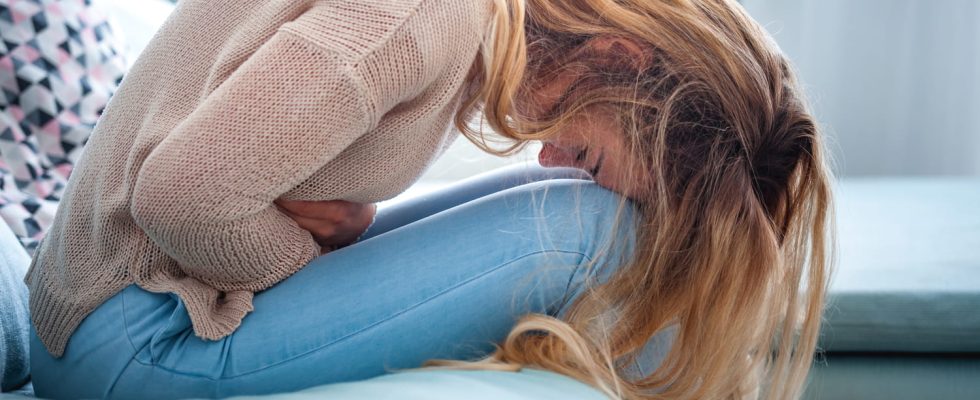Our gynecologist is categorical: “It’s not normal to have pain during your period.”
The menstrual cycle is a physiological phenomenon which punctuates women’s lives and which is accompanied by numerous symptoms: fatigue, mood changes but also sometimes pain. Gold “It’s not normal to have pain during your period“ explains gynecologist Odile Bagot. In medical language, painful menstruation is called “dysmenorrhea“. Dysmenorrhea can be primary when it occurs in adolescence or secondary when it appears throughout the menstrual cycles. It can have several causes and be more or less disabling on a daily basis.
Ovarian pain
Pain may occur around theovulation i.e. around the 14th day for women who have 28 day cycles. We talk about “cyclical” pain. “If a woman presents with cyclical pain, the reflex will always be to analyze them in relation to the date of the period. This is the benchmark. The healthcare professional will then be able to relate them to menstruation or not” explains Dr. Bagot. Ovulation results in a small 2cm cyst that bursts. It can lead to “sensations” in women who feel a temporary discomfort. There is nothing to worry about. On the other hand, if ovulation is associated with significant pain during 2 to 3 days, you should talk to the doctor. “Sometimes we see ovarian dystrophy, that is to say several cysts, or a functional cyst or even polycystic ovaries which are painful during the period of ovulation” continues the gynecologist. What should alert:
► A constant pain for a few days which is located in the small pelvis, often on one side or the other and occurs in the middle of the cycle.
► A pain awakened or accentuated during sexual intercourseespecially in the days following ovulation.
► A pain that persists : after ovulation, fluid in the pelvis will build up, particularly at the back of the uterus, causing sensitivity during intercourse which can fade or last for 7 or 8 days, sometimes even until the next period, while the liquid is absorbed.
The origin of the pain may be diagnosed with an ultrasound. “We will then treat the ovulatory pain according to its intensity; a simple analgesic may be sufficient. If this is not the case, the cause must be treated, that is to say, ovulation must be blocked with a pill”, specifies Dr Bagot.
Painful periods
Having an unpleasant, slightly painful feeling during your period is common and “is treated with paracetamol or an anti-inflammatory” but “any pain that alters quality of life must be taken care of and explored.” We must not get used to suffering during periods by telling ourselves that it is normal, especially as our interlocutor reminds us:having consequences on daily life because of your period is not not a fatality. We need to treat the pain, inflammation and contraction.”. In order :
- Anticipate pain, “do not wait until you are in pain to take your treatment”.
- Combine medications and take the right dose : against pain with paracetamol (maximum 3 gr per day), against inflammation with an anti-inflammatory (the dosage depends on the product), against contraction with Spasfon® (maximum 3 times 2 tablets at 80mg). “Do not hesitate to take the medications successively during the day.”
- If that’s not enough, consider taking the pill. In fact, most women on the pill no longer have period pain, “it is a contraceptive but also a treatment for dysmenorrhea” explains the gynecologist. Finally, if the painkiller or the pill are not enough, the causes of the pain must be explored, in particular the possibility of endometriosis.
Endometriosis
Endometriosis is a complex disease where the symptoms are multiple and not always correlated with lesions. The most constant sign, rather at the beginning of the disease, is “worsened” dysmenorrhea, that is to say that each month will be worse than the previous one. Many women with endometriosis also have pain outside of periods and sometimes outside the pelvis for example. To make the diagnosis, the doctor asks the patient about the following symptoms:
► pelvic pain, especially during menstruation
► pain during sexual intercourse
► non-gynecological pain : pain during urination (when urinating), digestive pain, anal bleeding during periods, etc.
The goal will be to associate the signs and observe their evolution, “the specialist will then seek to identify the endometriosis nodulesto trigger the pain with a vaginal examination to better identify it, then a specialized ultrasound and finally an MRI” explains the gynecologist. The most common treatment for endometriosis remains taking the contraceptive pill.
